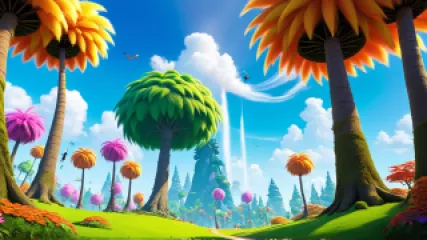Lessons from 'The Lorax' to Enhance Your Eco-Therapy Coaching Services
Lessons from 'The Lorax' to Enhance Your Eco-Therapy Coaching Services
In the whimsical world of Dr. Seuss, the story of 'The Lorax' has long captivated audiences with its powerful environmental message. Beyond the colorful illustrations and memorable characters, this beloved tale holds valuable lessons that can be applied to the world of eco-therapy coaching services. As eco-conscious mental health professionals, we have much to learn from the cautionary tale of the Lorax and the transformation of the lush, thriving Truffula Tree forest into a barren, industrialized wasteland.
In this article, we will explore how the themes and teachings of 'The Lorax' can be used to enhance the effectiveness and impact of eco-therapy coaching services. From cultivating a deep connection with nature to advocating for environmental preservation, the Lorax's unwavering determination and the Once-ler's gradual descent into greed offer profound insights that can guide us in our mission to support individuals and communities on their eco-friendly journeys.
Embracing the Language of Nature
At the heart of 'The Lorax' lies the Lorax's ability to speak on behalf of the Truffula Trees, the Bar-ba-loots, the Swomee-Swans, and the Humming-Fish – the myriad of living beings that call the forest home. The Lorax serves as a passionate advocate, using his unique perspective to give voice to the voiceless and highlight the devastating consequences of the Once-ler's industrialization efforts.
In the context of eco-therapy coaching, this lesson encourages us to cultivate a deep understanding and appreciation for the natural world. By immersing ourselves in the language of nature, we can better empathize with our clients' experiences and guide them towards a more harmonious relationship with their environment.
This might involve activities such as nature walks, where clients are encouraged to observe the intricate details of their surroundings, from the delicate patterns of tree bark to the rhythmic songs of birds. By fostering a sensory connection with the natural world, we can help our clients develop a more profound sense of belonging and a vested interest in protecting the ecosystems they have come to cherish.
Nurturing a Holistic Approach to Well-being
One of the core messages of 'The Lorax' is the interconnectedness of all living beings and the delicate balance of the natural world. As the Once-ler's greed and industrialization efforts gradually erode the Truffula Tree forest, we witness the devastating ripple effects on the Bar-ba-loots, the Swomee-Swans, and the Humming-Fish – all of whom are forced to abandon their homes and way of life.
This holistic perspective on the well-being of both humans and the environment is at the heart of eco-therapy coaching. By acknowledging the profound impact that our relationship with nature has on our physical, mental, and emotional health, we can help our clients adopt a more comprehensive approach to their eco-friendly lifestyle choices.
This might involve incorporating nature-based activities into therapy sessions, such as gardening, forest bathing, or even eco-art projects. By engaging the senses and fostering a deeper connection with the natural world, we can help our clients discover new avenues for stress reduction, mood enhancement, and overall well-being.
Advocating for Environmental Preservation
One of the most powerful aspects of 'The Lorax' is the Lorax's unwavering dedication to advocating for the protection of the Truffula Tree forest. Despite the Once-ler's relentless pursuit of profit, the Lorax remains a steadfast voice for the voiceless, tirelessly working to raise awareness and rally support for the preservation of the natural environment.
In the realm of eco-therapy coaching, this lesson inspires us to take a more active role in environmental advocacy. As professionals who deeply understand the profound impact that a healthy environment has on individual and community well-being, we are uniquely positioned to be agents of change.
This might involve collaborating with local organizations to host educational workshops, lobbying for eco-friendly policies and legislation, or even organizing community clean-up events. By leveraging our expertise and voice, we can empower our clients to become active stewards of the environment, fostering a sense of collective responsibility and a shared vision for a more sustainable future.
Cultivating a Regenerative Mindset
Perhaps one of the most profound lessons from 'The Lorax' is the importance of adopting a regenerative mindset – a belief that our actions can not only mitigate environmental damage but actively restore and revitalize the natural world.
In the story, the Lorax's final act before departing is to entrust the last Truffula Tree seed to the Once-ler, imploring him to "PLANT IT!" This gesture symbolizes the power of hope and the belief that even in the face of overwhelming destruction, the potential for renewal and regeneration still exists.
As eco-therapy coaches, we can instill this regenerative mindset in our clients by encouraging them to take an active role in ecological restoration projects, such as tree-planting initiatives or habitat rehabilitation efforts. By engaging in these hands-on activities, our clients can experience the tangible impact of their actions and develop a deeper sense of empowerment and investment in the health of their local ecosystems.
Fostering a Collaborative Community
One of the striking features of 'The Lorax' is the way in which the Lorax rallies the support of the various animal inhabitants of the Truffula Tree forest. From the Bar-ba-loots to the Swomee-Swans and the Humming-Fish, the Lorax creates a cohesive community of advocates who stand united in their defense of the natural environment.
In the context of eco-therapy coaching, this lesson underscores the importance of fostering a collaborative community of eco-conscious individuals. By creating opportunities for our clients to connect with like-minded people, we can help them build a strong support network and amplify their collective impact.
This might involve organizing eco-therapy support groups, hosting eco-friendly social events, or even facilitating partnerships between our clients and local environmental organizations. By cultivating a sense of community and shared purpose, we can empower our clients to become active participants in the movement towards a more sustainable future.
Embracing the Power of Storytelling
Finally, 'The Lorax' serves as a powerful example of the transformative potential of storytelling. Through the whimsical narrative and the vivid imagery of Dr. Seuss, the tale of the Lorax has become a beloved classic, resonating with generations of readers and inspiring them to consider the consequences of our actions on the natural world.
As eco-therapy coaches, we can harness the power of storytelling to amplify our message and connect with our clients on a deeper level. By incorporating narratives, metaphors, and analogies into our coaching sessions, we can help our clients better understand the complex environmental issues they are facing and empower them to become agents of positive change.
Whether it's sharing the story of the Lorax or drawing inspiration from other eco-themed narratives, the strategic use of storytelling can be a valuable tool in our eco-therapy coaching toolkit. By captivating our clients' imaginations and appealing to their emotions, we can inspire them to take meaningful action and become stewards of the natural world.
Conclusion: Harnessing the Lessons of 'The Lorax' for Eco-Therapy Coaching
In the enchanting world of 'The Lorax,' Dr. Seuss has gifted us with a timeless tale that offers profound lessons for eco-therapy coaching professionals. By embracing the Lorax's unwavering advocacy, the Once-ler's cautionary journey, and the interconnectedness of all living beings, we can cultivate a more holistic and impactful approach to supporting our clients' eco-friendly journeys.
Through activities that foster a deep connection with nature, a regenerative mindset, and a collaborative community, we can empower our clients to become active stewards of the environment. By harnessing the power of storytelling and advocating for environmental preservation, we can inspire our clients to take meaningful action and contribute to the broader movement towards a more sustainable future.
As eco-therapy coaches, we have the unique opportunity to be agents of positive change, guiding our clients towards a harmonious relationship with the natural world. By drawing inspiration from the timeless lessons of 'The Lorax,' we can unlock new avenues for personal growth, environmental healing, and collective empowerment – ultimately, creating a more vibrant and resilient future for all.
Throughout this article, we have explored how the themes and teachings of 'The Lorax' can be applied to the field of eco-therapy coaching. By embracing the language of nature, nurturing a holistic approach to well-being, advocating for environmental preservation, cultivating a regenerative mindset, fostering a collaborative community, and harnessing the power of storytelling, eco-therapy coaches can unlock new possibilities for supporting their clients' eco-friendly journeys.
As we continue to navigate the complex environmental challenges of our time, the lessons of 'The Lorax' serve as a powerful reminder of the interconnectedness of all living beings and the urgent need to protect and restore the natural world. By incorporating these lessons into our eco-therapy coaching practices, we can empower our clients to become active stewards of the environment, contributing to a more sustainable and resilient future for all.
Remember, the Lorax did not give up in the face of adversity – and neither should we. By embracing the Lorax's unwavering determination and the Once-ler's cautionary tale, we can inspire our clients to take meaningful action and become agents of positive change. Together, we can cultivate a world where the Truffula Trees once again sway in the wind, the Bar-ba-loots roam freely, and the Swomee-Swans and Humming-Fish thrive in their natural habitats.
So, let us heed the Lorax's call and "PLANT IT!" – not just the last Truffula Tree seed, but the seeds of hope, regeneration, and environmental stewardship within the hearts and minds of our eco-therapy coaching clients. By doing so, we can create a brighter, more sustainable future for all.
Keywords used in the article:
- ecotherapy coaching services
- eco-friendly mental health services
- eco-friendly life coaching






